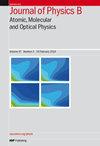Magnetic field enhanced laser absorption on a metallic surface incorporated with shape-dependent nanostructures
IF 1.5
4区 物理与天体物理
Q3 OPTICS
Journal of Physics B: Atomic, Molecular and Optical Physics
Pub Date : 2024-08-27
DOI:10.1088/1361-6455/ad6b68
引用次数: 0
Abstract
This communication proposes an analytical model to investigate the nanoparticle-based nonlinear absorption phenomenon associated with an obliquely incident p-polarized laser beam on a metallic surface. In this scheme, the surface is ingrained with noble-metal spherical nanoparticles and cylindrical nanoparticles in the presence of an external static magnetic field. The absorption of laser energy in the presence of nanoparticles (NPs) is attributed to surface plasmon resonance and enhanced magnetic-field effects. The absorption phenomenon is significantly enhanced by the incorporation of nanostructures and a magnetic field. The ellipticity characterizing parameter, which significantly influences the resonant frequency of different nanometric structures, has also been analysed and discussed. The effects of varying the magnetic field intensity, incident angle, size, and spacing of the NP were examined to determine their influence on the anomalous absorption of the laser. Furthermore, a direct dependency was found between the absorption coefficient and transmission coefficient of the incident laser, as well as the dimensions of the NPs. Several applications have direct relevance to this study, including biosensors such as DNA sensors and immunosensors, photothermal therapy, photoacoustic imaging, optoelectronic devices, solar cells, and surface-enhanced Raman spectroscopy.金属表面与形状相关纳米结构的磁场增强激光吸收
这篇论文提出了一个分析模型,用于研究与斜入射p偏振激光束在金属表面上相关的基于纳米粒子的非线性吸收现象。在这一方案中,表面在外部静磁场的作用下嵌入了贵金属球形纳米粒子和圆柱形纳米粒子。纳米粒子(NPs)对激光能量的吸收归因于表面等离子体共振和增强的磁场效应。加入纳米结构和磁场后,吸收现象明显增强。椭圆度表征参数对不同纳米结构的共振频率有显著影响,我们也对该参数进行了分析和讨论。研究了改变磁场强度、入射角度、尺寸和纳米粒子间距的效果,以确定它们对激光反常吸收的影响。此外,还发现入射激光的吸收系数和透射系数与 NPs 的尺寸有直接关系。与这项研究直接相关的应用包括 DNA 传感器和免疫传感器等生物传感器、光热疗法、光声成像、光电器件、太阳能电池和表面增强拉曼光谱。
本文章由计算机程序翻译,如有差异,请以英文原文为准。
求助全文
约1分钟内获得全文
求助全文
来源期刊
CiteScore
3.60
自引率
6.20%
发文量
182
审稿时长
2.8 months
期刊介绍:
Published twice-monthly (24 issues per year), Journal of Physics B: Atomic, Molecular and Optical Physics covers the study of atoms, ions, molecules and clusters, and their structure and interactions with particles, photons or fields. The journal also publishes articles dealing with those aspects of spectroscopy, quantum optics and non-linear optics, laser physics, astrophysics, plasma physics, chemical physics, optical cooling and trapping and other investigations where the objects of study are the elementary atomic, ionic or molecular properties of processes.

 求助内容:
求助内容: 应助结果提醒方式:
应助结果提醒方式:


